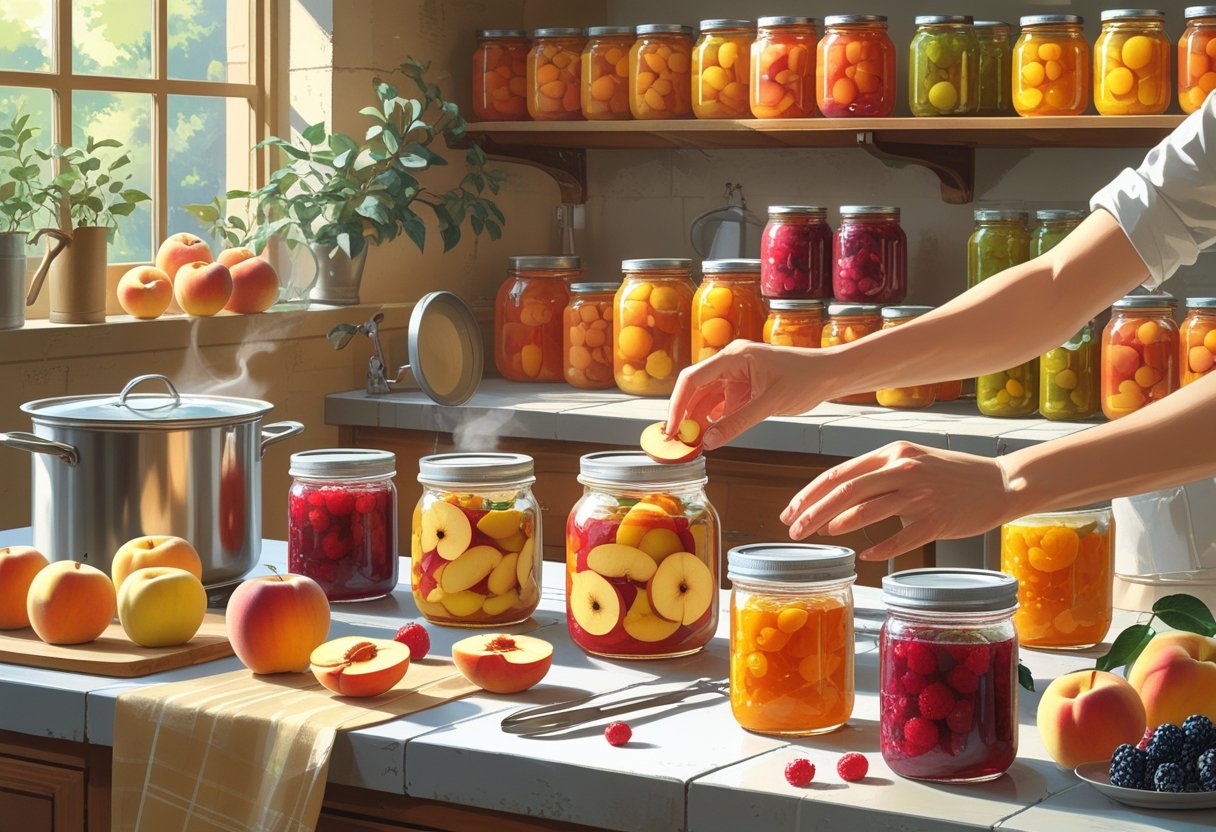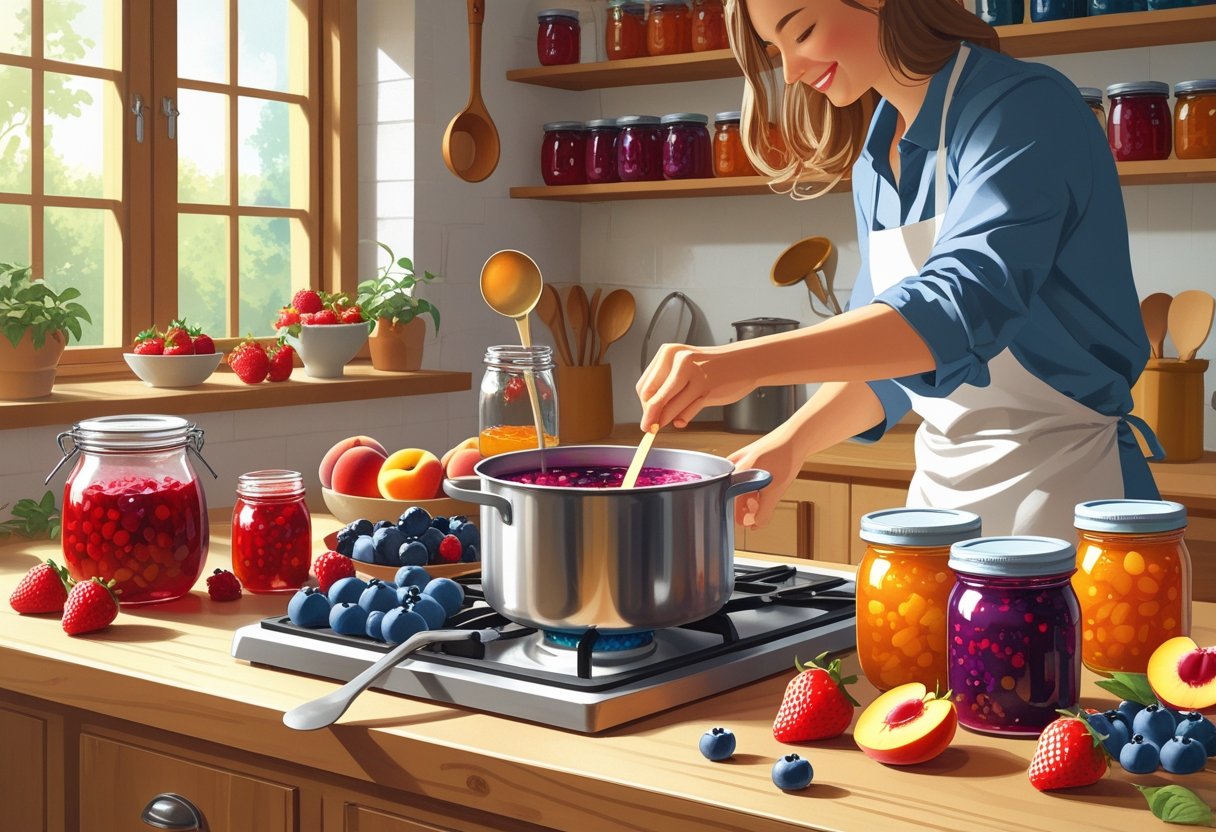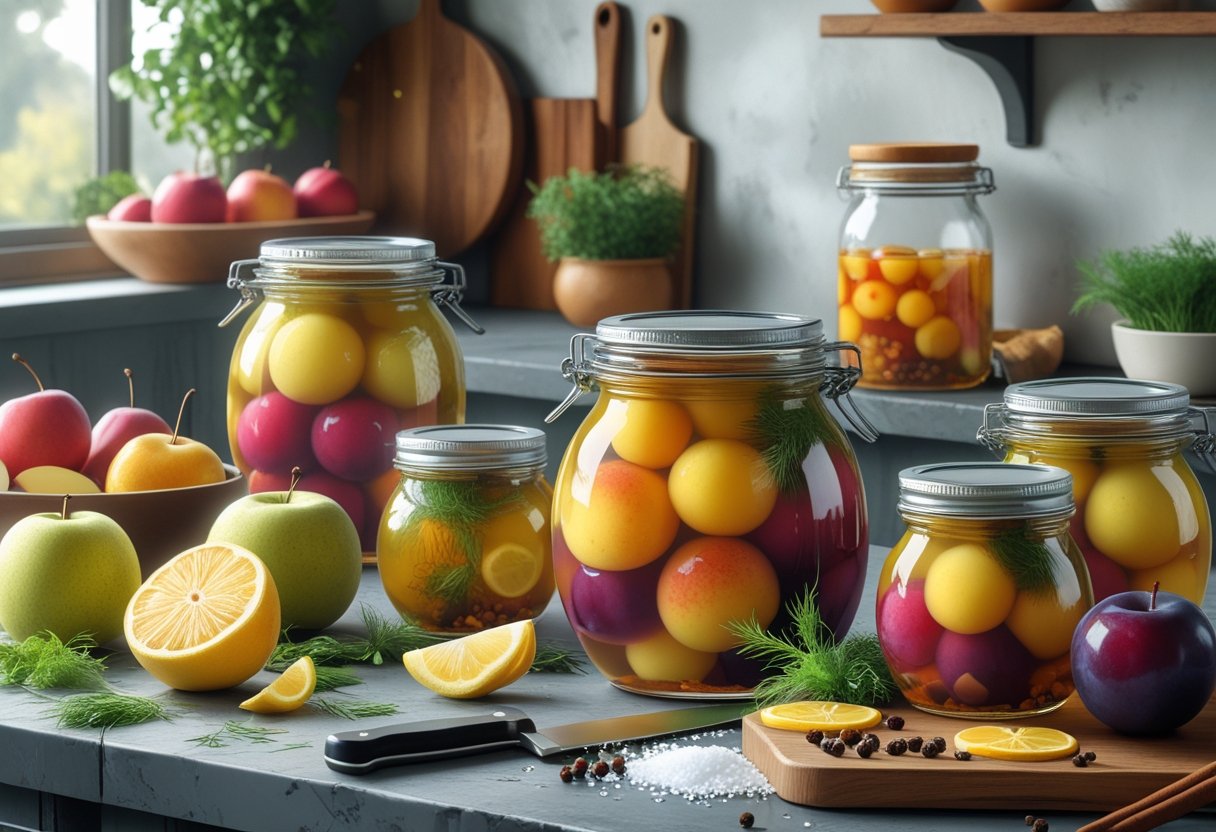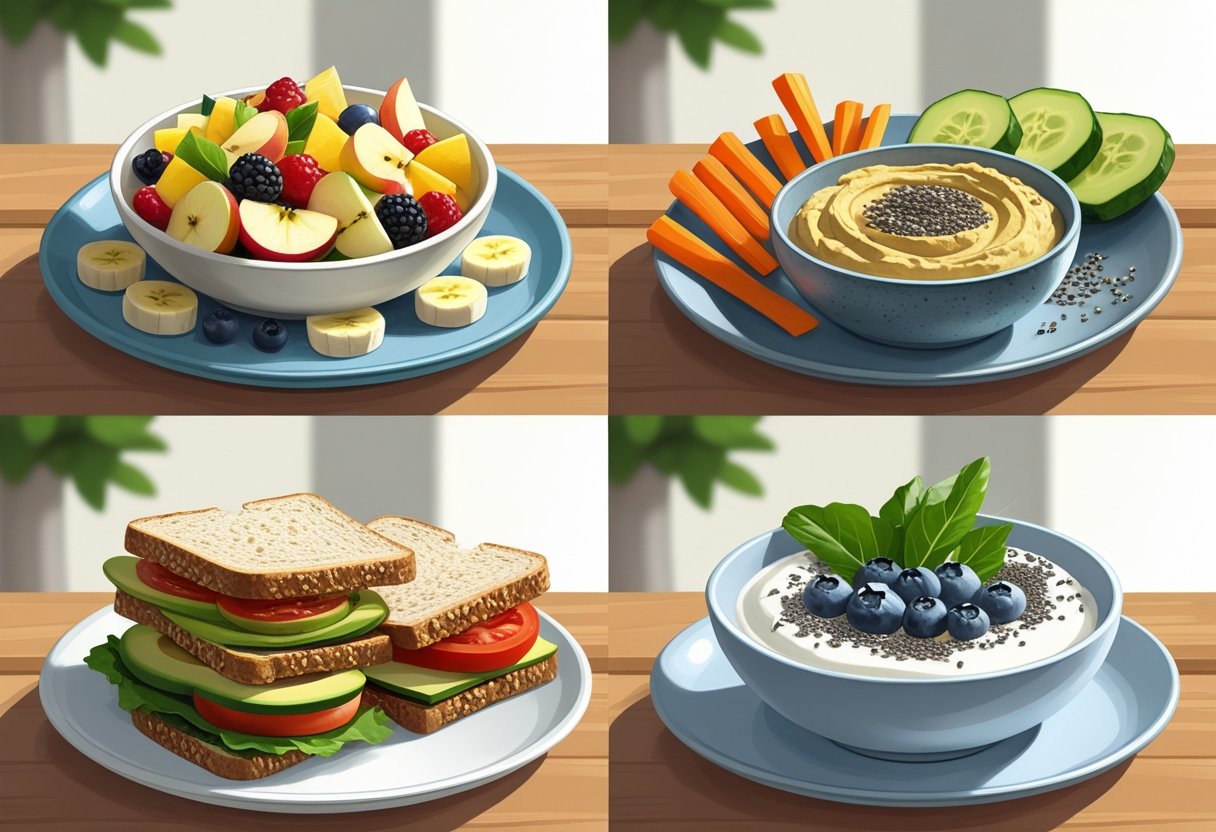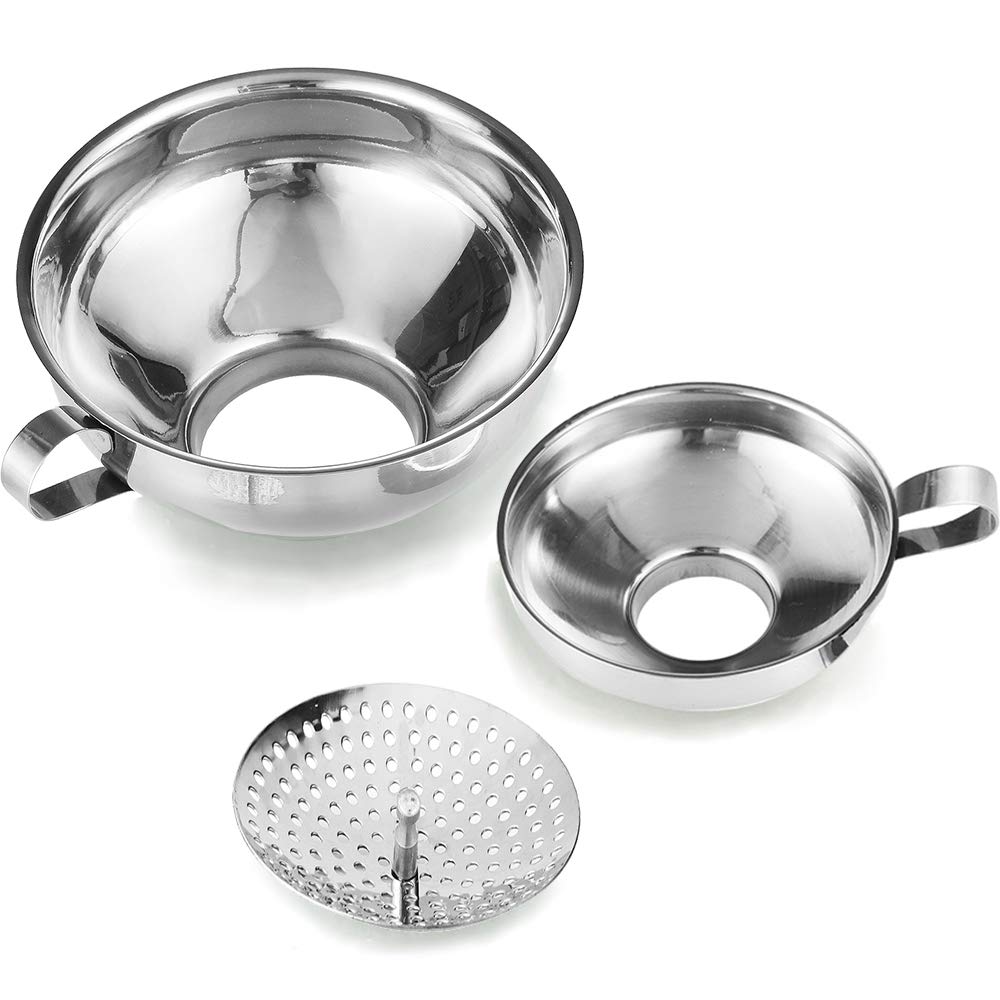Pickling turns fresh fruits into tangy, preserved snacks
by soaking them in vinegar-based brines. Quick pickling is great if you
want fast results and don't have special gear—perfect for small batches
or just experimenting.
Introduction to Pickling Methods
Traditional
pickling uses fermentation, which can take weeks or even months. This
method creates deep, complex flavors thanks to natural bacteria working
in salt brine.
Quick pickling skips the wait
and gives you pickled fruit in about 30 minutes. Instead of fermenting,
you just use an acidic solution and pop it in the fridge.
The big difference? Texture and flavor. Quick pickles stay crisp and bright, while traditional ones taste a bit funkier and get softer.
Best Fruits for Pickling:
- Apples and pears
- Stone fruits (peaches, plums, nectarines)
- Grapes
- Firm berries
Fruits that aren't too watery hold up best since they keep their shape in the brine.
Using Vinegar Brine and Spices
A
basic vinegar brine needs just four things: water, vinegar, salt, and
sugar. Usually, you go with equal parts water and vinegar, then add salt
and sugar to taste.
Basic Brine Recipe:
- 2 cups water
- 2 cups white or apple cider vinegar
- 3 tablespoons salt
- 1 tablespoon sugar
The vinegar keeps things safe and tangy. Salt brings out flavor and helps with texture, while sugar smooths out the sharpness.
Spices
make it interesting. Cinnamon and cloves are perfect for apples, ginger
loves stone fruits, and black peppercorns or bay leaves work with just
about anything.
Heat the brine so the salt and sugar dissolve completely. That way, everything preserves evenly and tastes right.
Quick Pickling for Small Batches
Quick pickling really shines when you've got just a handful of fruit that you know you won't eat in time. It's a lifesaver for single servings or just enough to last the week.
Grab
some clean, fresh fruit and cut it into pieces that look about the same
size. Toss the fruit into sterilized jars, but don't forget to leave
about half an inch of space at the top.
Pour hot brine over the fruit and make sure everything's completely covered. You want every piece to soak.
Seal
up the jars and pop them straight into the fridge. Most quick pickles
hit their stride somewhere between 24 and 48 hours—after that, they're
good for up to a month as long as you keep them cold.
This method doesn't just keep food from going to waste; it also lets you whip up surprisingly fancy ingredients
from stuff you already have. Since you're only making a little at a
time, you can play around with spices and flavors without a big
commitment.
You don't need a bunch of canning gear or
anything complicated. Just grab some regular jars and basic pantry
staples, and you can make pickled fruit that's honestly on par with what
you'd get at a restaurant—but for way less money.
Freezing, Vacuum-Sealing, and Other Modern Approaches
These
days, we've got some pretty clever ways to keep fruit fresh. By playing
with temperature and cutting out oxygen, you can stretch the shelf life
from a few weeks to well over a year—without sacrificing nutrients.
Freezing Fruits for Freshness and Nutrition
Freezing stops bacteria in its tracks by dropping the temp to 0°F or below. That pretty much puts a pause on everything that makes fruit go bad.
Most
fruits keep 85-95% of their original vitamins and minerals if you
freeze them right. Berries, cherries, and grapes especially hold up
well, probably thanks to their lower water content.
Stone fruits—think peaches and plums—need a little prep or they'll end up brown and weirdly textured.
Optimal freezing temperatures:
- Home freezers: 0°F to -10°F
- Deep freezers: -10°F to -20°F
- Commercial flash freezing: -31°F
Flash freezing is the gold standard
since it forms tiny ice crystals that don't wreck the fruit's
structure. Slow freezing? Not so much—it usually leaves you with mush.
Frozen
fruit will stay solid for 8-12 months in a regular freezer. If you have
a deep freezer, you can stretch that to 18-24 months and still keep
most of the nutrition intact.
Blanching and Its Importance
Blanching
means dunking fruit in boiling water for a bit, then cooling it fast in
ice water. This step knocks out the enzymes that mess with color,
flavor, and nutrients during freezing.
Recommended blanching times for common fruits:
- Apples (sliced): 2-3 minutes
- Peaches (halved): 3-4 minutes
- Pears (quartered): 2-3 minutes
- Apricots (halved): 2-3 minutes
Timing here is everything. Go too long and you lose nutrients and end up with mush; too short and you don't stop the enzymes.
Right
after blanching, throw the fruit into ice water for just as long as you
boiled it. That stops the cooking and helps the fruit keep its shape.
Some
fruits—like berries, grapes, and citrus—skip the blanching altogether.
They're acidic enough, and their enzymes aren't really a problem, so you
can just wash, dry, and freeze them as they are.
Vacuum-Sealed Bags for Long-Term Storage
Vacuum sealing removes air to slow bacterial growth and helps prevent freezer burn, which really wrecks fruit quality over time.
This
method can stretch out frozen fruit storage by 3-5 times compared to
tossing fruit in regular plastic bags. It's kind of wild how much longer
things last.
Vacuum-sealed bags keep things airtight, blocking oxidation and moisture loss.
Fruits keep their original color, flavor, and—let's be honest, the big one for some people—nutritional content for way longer.
Storage duration comparison:
- Regular plastic bags: 6-8 months
- Vacuum-sealed bags: 2-3 years
- Combined with deep freezing: 3-5 years
Vacuum sealing works best when combined with freezing to create ideal preservation conditions.
No air means no ice crystals forming on fruit surfaces, which is a relief if you've ever bitten into a weirdly icy strawberry.
Delicate fruits like strawberries and raspberries need partial vacuum sealing so they don't get squished.
Firmer fruits—think apples and pears—can handle full vacuum pressure without any issues.
If
you pre-freeze fruits for a couple hours before vacuum sealing, you can
stop juices from getting sucked out during the process.
This
little trick keeps fruit intact and helps avoid bag seal failures,
which is honestly a lifesaver if you've ever had a leaky mess.

